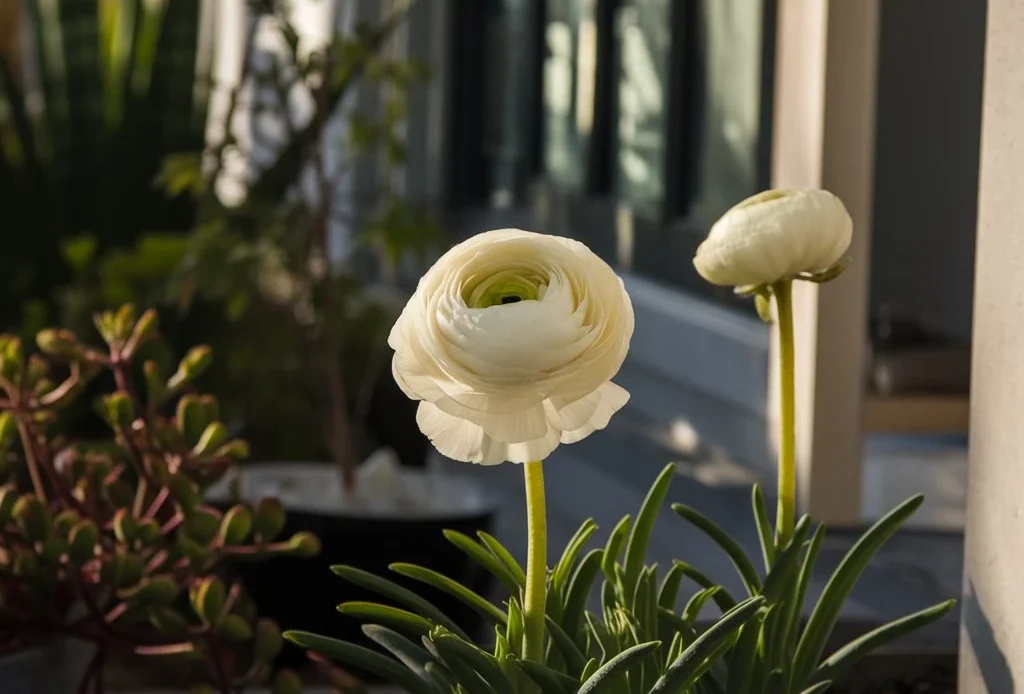
Overview of the Butterfly Ranunculus Flower
People adore the unique butterfly ranunculus. It’s a lot more special than your everyday ranunculus. Your usual ranunculus kind of looks like a rose. The butterfly ranunculus? It’s lighter, easier on the eyes. When you see it, it’s like watching a butterfly resting. This flower looks almost see-through. It subtly stands out, adding a soft shine where needed. And it’s perched on long, thin stems. This lets it move around in a breeze, giving things a nice flow.
Table of Contents
Unique Characteristics: Why Butterfly Ranunculus Stands Out
A well-known flower choice, the butterfly ranunculus, is loved for its charming, delicate petals and ability to survive long after being cut, often exceeding two weeks in a vase. That’s why many pick it for arrangements that need an extended life. Available in plenty of colors, from soft pinks and whites to bright corals, yellows, and rich purples, it offers options for everyone. Growing butterfly ranunculus brings a special sight – their petals can sometimes shimmer with different tones depending on the light, like a magical touch. Its combination of beauty, endurance, and this unique trait has led to its popularity, especially in wedding bouquets, floral installations, and home décor.
Origins and History of Butterfly Ranunculus in Cultivation
Butterfly ranunculus is native to the Mediterranean. Thanks to the region’s soft weather and well-drained soil, it flourishes. Although new to the flower business, it’s well-liked because of its stunning beauty and toughness. This plant has been carefully bred for its unique, delicate shape and bright colors, making it a top choice among other Ranunculus types. Special care is necessary for these plants to thrive in cultivation. Farmers have figured out methods that help them adjust to different climates outside their native Mediterranean. This has widened their allure in gardens and flower shops all over the world. They’ve become more popular because they’re not just good to look at but also last long. This shows an increasing interest in flowers that add natural grace to everyday places.
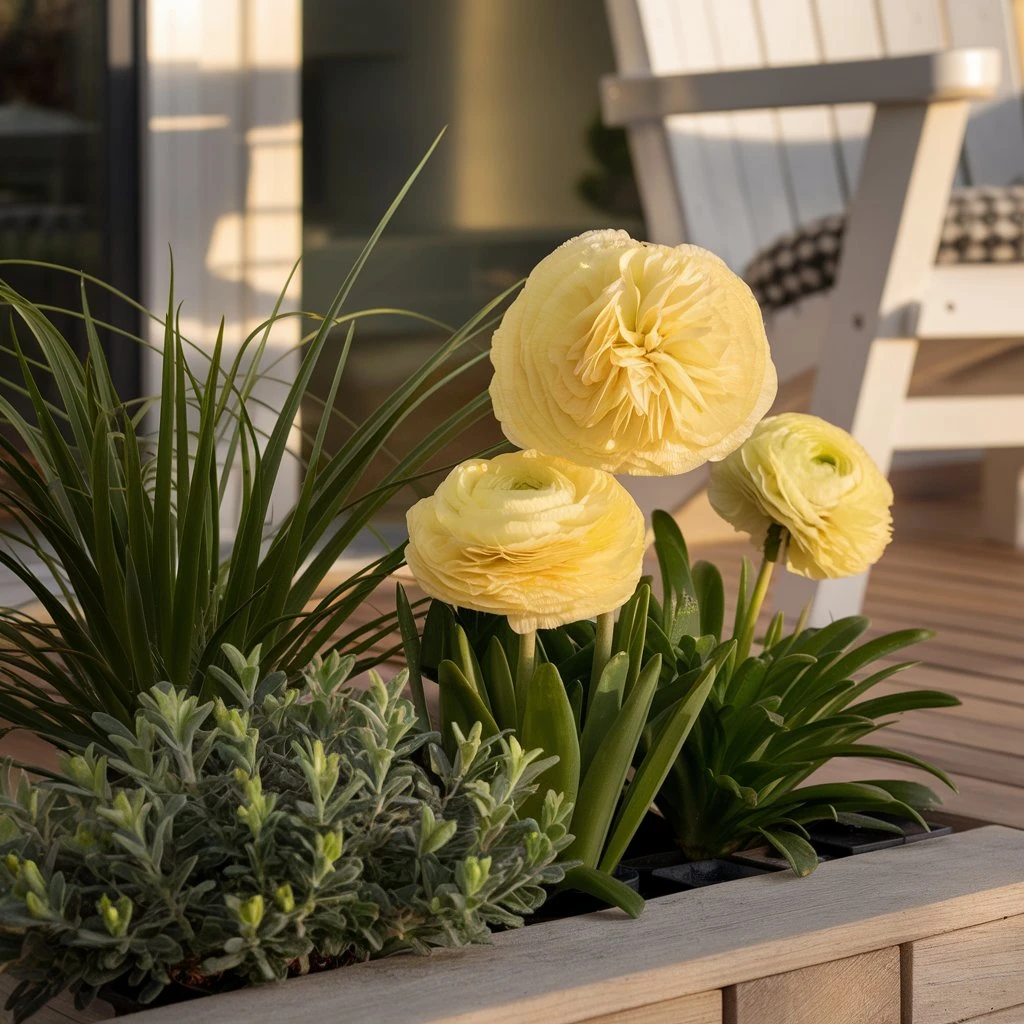
Types and Varieties of Butterfly Ranunculus
Popular Butterfly Ranunculus Varieties: Colors, Shapes, and Textures
The butterfly ranunculus comes in lots of colors and textures. It’s great for gardens and flower vases. It’s not like typical ranunculus. It has petals that are open, sometimes curled, or a little frilly. This makes it look lighter and more nature-like. It varies from soft colors like light pink, white, and peach to bright ones like coral, yellow, and dark purple. Some even mix colors subtly. This makes them appear as if they were painted with watercolors.
“Elegance” dahlias are common picks. They shine with a metallic brightness. This makes their petals look like they’re glowing, adding mystery and softness. The “Hanoi” is another top pick. It presents a light pink blush tone, ideal for weddings or romantic outdoor spots. The “Romantic Pastel” group has a range of soft pastel colors. It’s just right for a peaceful, balanced garden or bouquet look. Each type of dahlia has its own unique beauty, giving plant enthusiasts and flower experts the freedom to select the ones that fulfill their vision and color scheme.
Differences Between Butterfly Ranunculus and Other Ranunculus Types
The butterfly ranunculus isn’t like other ranunculus types. You can find many kinds of ranunculus that look like tiny roses or peonies because of their thick, layered petals. They make bouquets look fancy and full, perfect for weddings. But the butterfly ranunculus is cool. It doesn’t have as many petals, so it looks chill and free-spirited. Its petals are thin and a bit see-through, creating a gentle glow when light hits them—not something you see in common ranunculus flowers.
Butterfly ranunculus plants are unique. They’re taller with longer stems, which is a great feature for flower arrangements that need height and movement. They have strong, flexible stems that move with the wind, giving a lively touch to gardens. Because of these traits, butterfly ranunculus became a favorite among people wanting a modern yet elegant flower, like the classic ranunculus.
How to Choose the Best Variety for Your Garden or Bouquets
Picking the right butterfly ranunculus type isn’t just about color. Sure, bold yellows and corals can make your garden pop. Pastels are great for bouquets and centerpieces. But you have to think about the weather too. Not every variety can handle every climate. And let’s not forget what you’re using them for. Are they going outside in the ground or inside in a vase?
Think about the weather too. Butterfly ranunculus plants do better in cooler weather and need soil that drains well to keep the roots from rotting. If you’re planting in a hot area, pick types that can handle it, or put them in partly shady places to make them bloom longer. If you like cut flowers, go for ones that stay fresh in a vase for a long time, like the “Elegance” series. Whether you want to beautify your garden or a bouquet, there’s a butterfly ranunculus for everyone.
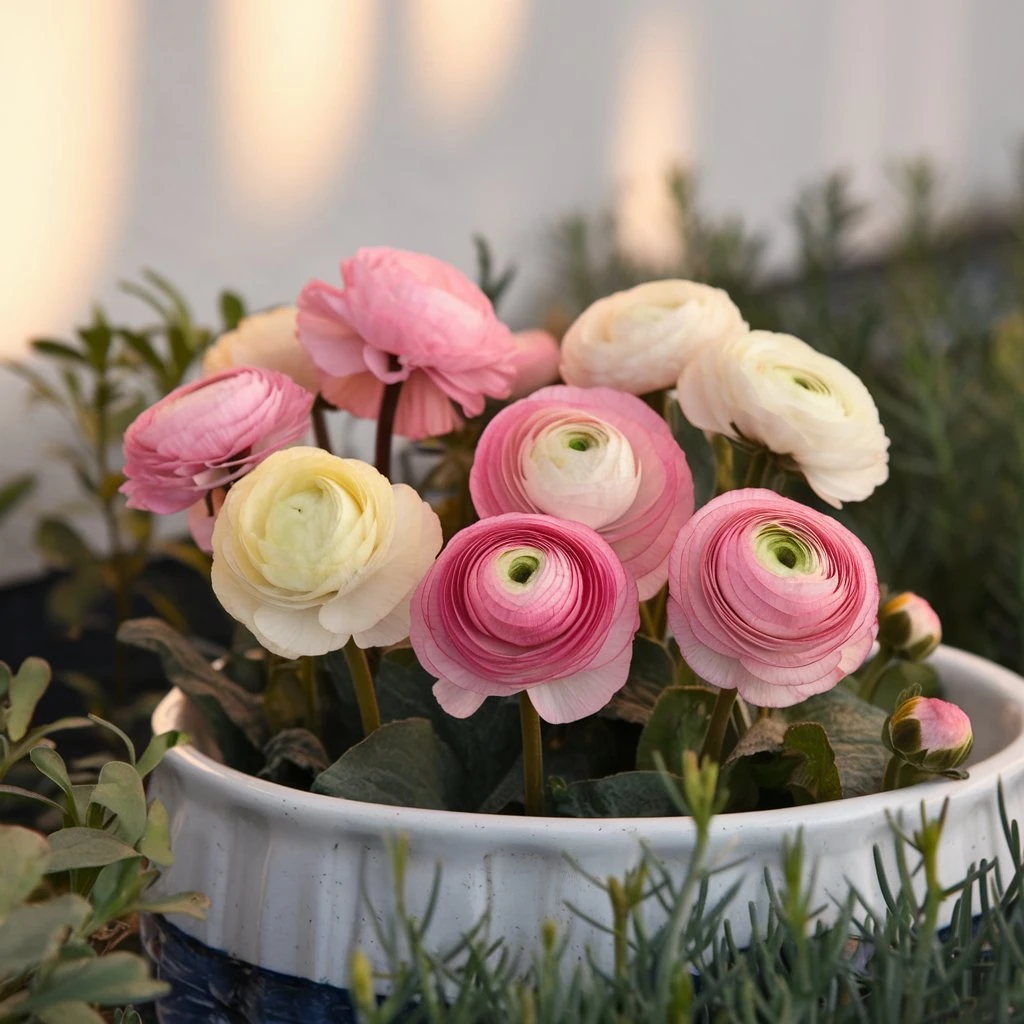
Growing Butterfly Ranunculus: Essential Tips and Tricks
Ideal Climate and Soil Conditions for Successful Growth
Want to grow lively butterfly ranunculus? You need to know their preferred weather and dirt. These delicate flowers do best in cool, gentle climates, not too warm or cold. Ideal temperatures for them are between 55°F and 65°F (13°C to 18°C) during the day and above freezing at night. If it gets too hot or damp, the flowers may not last or look as good. You might find it helpful to plant them when it’s cooler or add shade when the sun is strong.
Butterfly ranunculus needs good draining, somewhat acidic soil to steer clear of root decay. It thrives on sandy loam or light clay soils given their top-notch air provision, preventing excess water. A PH scale between 5.5 and 6.5 works best as it takes up nutrients effectively and encourages the best growth. If you add some organic compost before planting, the soil structure improves, helping in draining water and retaining nutrients, which are important for a thriving Ranunculus bed.
Planting Season and Best Time to Plant Butterfly Ranunculus
When you want to grow beautiful butterfly ranunculus plants, your timing is key. In areas with less chill, early spring is good for planting the bulbs. But in areas where it hardly ever freezes, try planting them in late winter. If you live in a colder place, here’s a helpful trick. Start the bulbs indoors during the last part of winter. Then, when it’s less frosty, move them outside. This helps extend their growing time and gives you bigger, stronger blooms.
Planting ranunculus early is smart. It allows them to get their roots going before it gets hot. If it’s too warm for too long, they might not bloom for as long. People in hot places can plant in late fall for winter or early spring flowers. It’s a good way to skip the summer heat and enjoy cooler temps. Remember to take note of when frosts usually happen. You’ll want to plant 6 to 8 weeks before the last frost. This gives the ranunculus time to get used to where they’re growing.
Step-by-Step Guide to Planting: From Soil Preparation to Spacing
Getting ready for butterfly ranunculus planting starts with prepping the soil right. First, loosen the soil deep, around 6 to 8 inches, and toss out any rocks or junk that can slow down root growth. Stir in lots of compost or aged manure to make the soil rich in nutrients. This will help make a nutrient-packed place that promotes robust tuber growth.
To start, give the ranunculus tubers a 3-4 hour soak in water that’s at room temperature. Pre-soaking gets the roots growing fast once they hit the soil. As you begin to plant, the “claws” should be faced down and deep about 1-2 inches into the earth. Also, spacing matters: keep each tuber about 6-8 inches apart. This gives each plant the right amount of room it needs to grow without it getting too crowded. And remember, too many plants too close together can cause less air to flow around them, upping the chance for fungus to grow.
Put soil over the tubers, pressing it lightly to get rid of any air near the roots. Don’t water right after planting. Instead, wait for the first growth signs that might appear in about 10 to 14 days. This method keeps the tubers moist but not too wet.
Watering, Sunlight, and Fertilizing Needs for Optimal Growth
The butterfly ranunculus, once it starts growing, needs regular watering. They like their soil to be damp but not soaking. Give them a good soak every week or when the top layer of soil gets dry. Keep a close eye on the soil moisture when it’s hot since it dries up quickly. But be careful! Too much water can cause the tubers to rot or create other problems with the roots.
Ranunculus plants love a sunny spot, but they’re okay with a bit of shade if it’s really hot out. Try to give them six hours of sun each day to help them grow big and produce colorful flowers. If you’re growing ranunculus in pots, put them where they can get good exposure to southern light. Use potting soil that drains well to stop too much water from being around the roots.
Help your butterfly ranunculus bloom by feeding it during its growth period. A slow-release mix, rich in phosphorus and potassium, works best; apply it approximately once a month. Avoid fertilizers high in nitrogen; they can lead to too many leaves and not enough flowers. If you prefer organic methods, try fish emulsion or bone meal. They offer necessary nutrients and are gentle on delicate roots.
Getting to know the butterfly ranunculus and what it requires – like its preferred weather, earth, planting methods, and continuous attention – helps gardeners delight in a lengthy show of this enchanting bloom all season long.
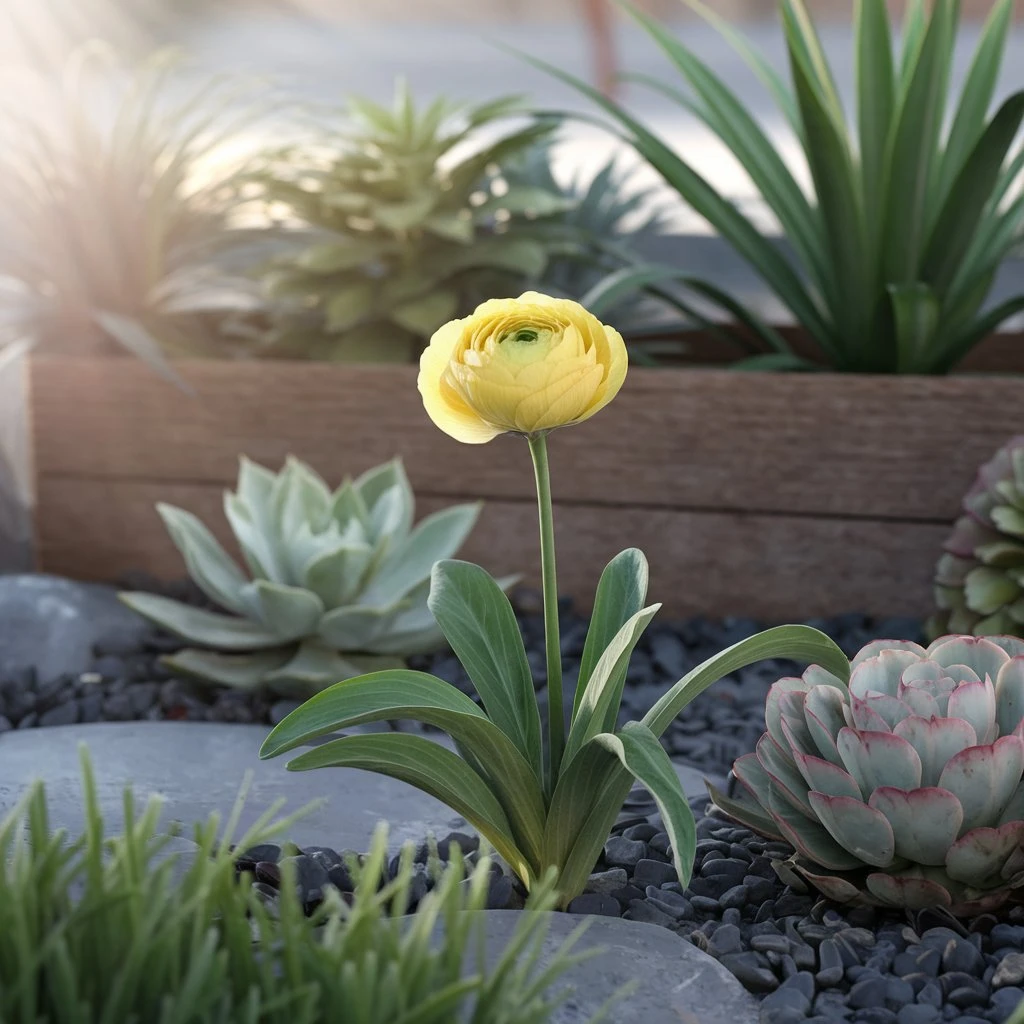
Caring for Butterfly Ranunculus Throughout the Season
Seasonal Care: Spring, Summer, and Fall Maintenance
Butterfly ranunculus need care tailored to each season to flourish. Watering rules change in Spring when these beauties wake up. The soil should stay consistently moist but also well-drained to avoid root rot. At the start of the growth season, try a steady, gradual-release fertilizer. It aids new growth and results in bright blooms. Beware of late frosts though. Guard the young flowers at night by covering the plants.
As the warm season comes, managing heat is critical. The Ranunculus flower cherishes cooler weather, so give them some shade during the afternoon in sizzling areas, particularly if the temperature goes beyond 75°F (24°C). Adding mulch around these blooms can keep the ground moist and balance the heat at the roots, which is helpful when it’s dry or scorching outside. Always remember to water these flowers consistently but watch out, as very damp soil in hot weather can draw in fungi issues.
When autumn comes, it’s readying time for butterfly ranunculus to sleep. Slow down watering, letting the leaves fade and droop on their own. This shows the plant’s set to chill for winter. A thin cover of compost or Earth-friendly mulch keeps the tubers cozy during the cold spell. In areas with gentle winters, ranunculus flowers may stay in the soil. Though, some extra safeguarding with a straw blanket or leaf cover will be good.
Common Pests and Diseases: Prevention and Treatment
Ranunculus, or butterflies, are mostly strong. Like their fellow plants, they can sometimes be bothered by bugs and diseases. Usual garden bugs like aphids, spider mites, and thrips can sometimes nibble on Ranunculus petals. They munch on the leaves and make the plant weak. Using a soft spray of bug-killing soap or a plant oil like neem oil can keep these bugs away. This doesn’t hurt the good insects. Checking plants regularly for bug problems helps us spot issues early. This allows for quick action.
Butterfly ranunculus is susceptible to issues like powdery mildew and root rot. These problems commonly arise due to dampness or poor drainage. To avert such issues, maintain good air circulation around the plants. This can be achieved by not overcrowding them and pruning packed growth. Morning watering lessens the odds of fungus development as it lets the leaves dry out during the day. If powdery mildew does occur, remove and dispose of the spoilt leaves properly. Using a sulfur-based fungicide is a wise decision if the issue continues.
Deadheading and Pruning Tips to Prolong Bloom Time
Caring for butterfly ranunculus involves two main actions: trimming and deadheading. Deadheading is when you take off dying flowers right when they begin to lose their vibrancy. Not only does this make your plant look better, but it also helps the plant switch focus from making seeds back to making new flowers. This extends the time your plant is in bloom. To deadhead, you’ll need garden scissors or pruning shears that are sharp. Look for the first healthy leaves beneath the wilting flower, and snip just above them.
Keeping your Ranunculus flowers tidy with routine trimming can shape the plant and promote bulkier growth. Cut back any stretched out stems or sickly leaves to allow for better airflow and sunlight within the plant. Moderate pruning helps keep the plant healthy and disease-resistant, while fostering a stronger, well-shaped plant. Always remember to use clean, germ-free pruning tools to prevent spreading diseases between plants..
Preparing for Dormancy: Overwintering Tips and Storage
It’s important to get butterfly ranunculus ready for the rest period. This helps them come back stronger next season. If you live where winters are tough, remove the tubers before frost hits. With a garden fork, dig round the plant, careful not to harm the tubers. Brush off extra dirt. Let tubers dry in a spot that’s cool, shaded, and well-aired for several days.
Put the Ranunculus flower bulbs in a box with peat moss, sand, or vermiculite once they’re dry. This keeps their surroundings steady and not too damp. Keep the box in a cold, dark spot. It’s best if it’s between 40°F and 50°F (4°C to 10°C). Look now and then for any bulbs getting mold or rot. If you spot damage, take the bulb out straight away so it can’t spread.
In places with gentler winters, caring for overwintered Ranunculus can be easy. Just pile a good amount of mulch over the garden bed. This blanket helps safeguard the tubers from wild temperature changes and lets them stay put in the soil. When spring arrives, with warmer weather and more sunlight, the plants woke up from their sleep. They are all ready to start a new round of healthy growth and charming flowers.
Butterfly ranunculus is quickly loved in floral design, known for its different petal shape, fine beauty, and outstanding vase life. Regular ranunculus varieties, with many layers of tight petals, stand apart from butterfly ranunculus. This kind has semi-double flowers with an open, wave-like shape, like a butterfly’s wings. This distinctive style and bright colors make it a popular pick for arrangements, bouquets, and centerpieces.
The durability of the Ranunculus flower as a cut addition is extraordinary. These blooms, once plucked, can retain their freshness for a period of around two weeks, a notable feat for delicate flowers. To ensure their longevity in a vase, it’s important to pick the stems at the precise time—just when the flowers start to unfold, revealing a glimpse of their ultimate hue. This makes sure they’ll open up attractively in the vase, offering prolonged pleasure and elegance in flower arrangements.
Ranunculus gardening tips come in a range of colors, which boosts their appeal. They sport light shades like baby pink and off-white as well as bright tones like fiery orange, vibrant coral, and rich purple. These flowers can enhance diverse themes, from traditional to contemporary. The ranunculus’s flexibility makes it a perfect match for other flowers or for simple, unadorned designs. Butterfly ranunculus, for instance, are often combined with plants like eucalyptus or ferns by florists. This approach accentuates their fragile appearance without overshadowing their distinct shape.
Want to make your Ranunculus flower cut last? It’s simple. Care and conditioning make all the difference. When you cut them, drop them promptly in fresh water with floral food. An angled cut on the stems means more water will be absorbed. Put your flowers where the light is cool and indirect to keep them looking good for longer. Showing a little love by changing the water every couple of days and giving the stems a quick trim can boost how long your flowers stay fresh.
From grand weddings to relaxed home settings, the guide on Ranunculus flowers infuses a classy and delightful vibe everywhere. Their elegant petals, enriched by a bright array of colors and their strong, lasting nature, make them an exceptional addition to all floral arrangements. Be it a lavish bouquet or a humble bud vase, the butterfly ranunculus shines, symbolizing nature’s beauty. It grabs attention and lifts the mood with its captivating charm.
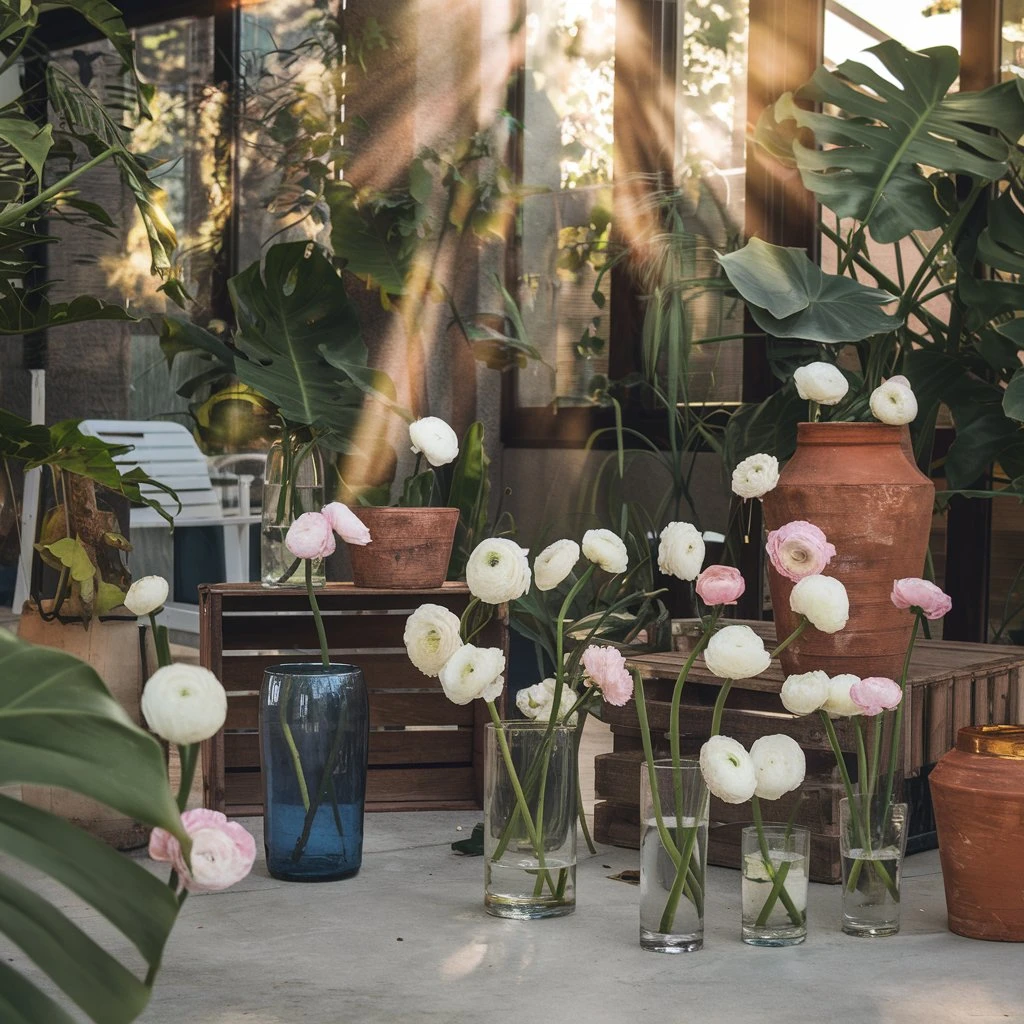
Butterfly Ranunculus as a Cut Flower
Why Butterfly Ranunculus is Popular in Floral Arrangements
Butterfly ranunculus This flower quickly became a sensation for its unique form, bright shades, and grace. Butterfly ranunculus stands out from usual varieties by having a more open structure instead of dense layers. Its shine gives it an almost dreamy appeal as it plays with light. Its beauty and versatility have made it popular with flower arrangers and event planers alike. Whether the event theme is traditional or modern, these flowers are a perfect fit. Since Ranunculus flowers come in a wide color spectrum – from gentle pastels to vibrant colors – they’re adaptable, fitting into just about any theme or setting.
Also, caring for Butterfly ranunculus can let it last in a vase for up to two weeks. This sturdiness, plus its elegant look make it a star in bouquets and centerpieces. Its airy, playful style matches well with other light flowers like sweet peas, peonies, and lisianthus. It also blends with greens like eucalyptus and ruscus, enriching both classy and laid-back arrangements.
Best Practices for Cutting and Storing Butterfly Ranunculus for Bouquets
Picking Butterfly Ranunculus at the perfect time is key to making them last longer and look their best in a vase. Cut the stems when the buds are barely starting to open and show a smidge of color for the best outcome. This lets the petals completely spread out in the vase, giving a grand and enduring show.
Right after you cut them, put the stems in clean, cool water. The water should ideally have a floral preservative to lessen bacteria and feed the flowers. For better water absorption, cut the stems at a 45-degree angle. If any leaves drop into the water, make sure to take them out. This will stop them from going bad. After you cut them, put the flowers somewhere cool and dark to rest for some hours. This lets them take in enough water. This important step, called the conditioning phase, helps the flowers stay fresh longer and gets them ready for showing off.
Before you start arranging Ranunculus flowers, it’s crucial to store them properly. A cool room works best, but watch out for sunlight, breezy spots, and ripe fruits. Unexpectedly, ethylene gas from fruit can make these flowers wilt faster. Popping them in the fridge is a good practice, but mind the temperature – too chilly, and they might not last long.
Tips for Extending Vase Life and Display Ideas
If you want your butterfly ranunculus to stay fresh, here are some easy tips. Replace the water every two days and add a dose of flower food. This stops bacteria from growing. Snip the stems a bit every time you change the water. This helps them drink up the water well. Keep your flowers in a cool spot. They don’t like it hot, or breezy, or too bright. Those things can make the flowers droop ahead of time.
Think about setting up Ranunculus flowers in clean-cut vases. This helps their genuine charm shine. Transparent glass or ceramic vases do great, highlighting the flowers without interference. Want something intense? Match them with green plants and other smooth-feel flowers in varied setups. The stretched, elegant stems of butterfly ranunculus make them fit for falling designs. This adds rhythm and swing to the view.
Butterfly ranunculus, even in a plain bud vase or a grand centerpiece, brings elegance and appeal. Its unique shape and lasting allure makes it perfect for any flower bundle, drawing eyes and adding class that fits with all room styles.
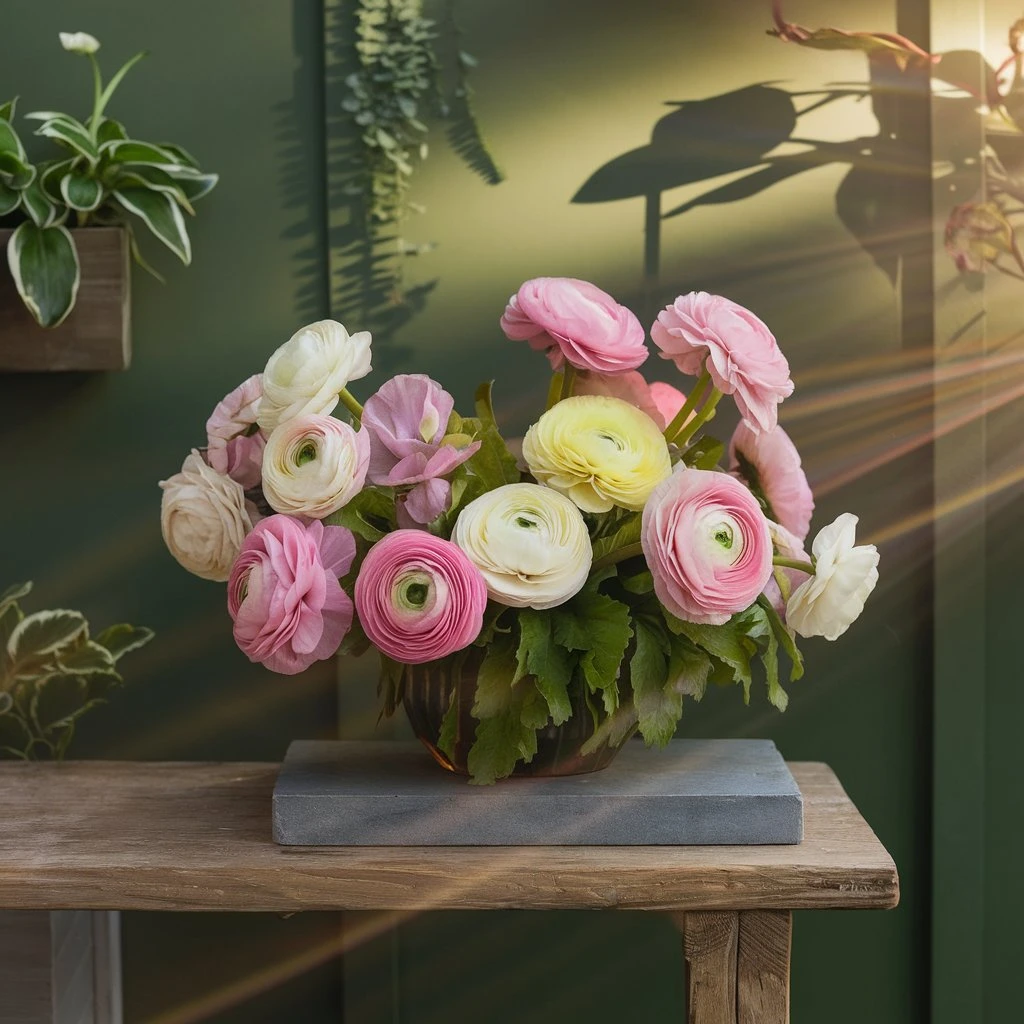
Propagation and Multiplying Butterfly Ranunculus
How to Collect and Store Seeds for Propagation
If you want more butterfly ranunculus, getting seeds from big plants is handy but needs care. Wait till blossoms are fully grown and starting to dry on the plant. When the flower heads turn brown and dry, pick them gently from the stems, gathering any seeds inside. Ranunculus seeds are tiny, so handle them gently, ideally over a neat, dry area to avoid loss.
For correct seed storage, put them in a paper envelope that breathes or a little container with a label. Don’t use plastic bags or closed containers, since seeds need air to stay healthy and stop moisture. Keep the seeds in a cool, dry space, like a fridge or a dark cabinet, until the next time you plant. Seeds can stay healthy for a year if stored right, even though the growth rate may lessen over time.
Dividing Tubers: A Step-by-Step Guide
Butterfly ranunculus tubers can be split to get more plants. This method replicates plants exactly, not like seeds. You get the same plant with the same color, shape, and strength. Doing this in late fall or early spring works best because the plant is either sleeping or just starting to grow. When you’re ready to split the tubers, be gentle.
Tap the soil away from the ranunculus flower plant taking care not to hurt the tubers. Lift up the tuber cluster, shake off extra dirt. Look for tiny divisions in the tubers. Each split should have a couple of budding points, that’s how you know it can grow. With a clean, sharp knife, cut between these clusters carefully, without hurting the buds. Afterward, let the tubers dry.
Keep them in a shady, dry spot for a day or two. This makes sure they won’t rot when we plant them later. Plant each splitted tuber on its own in soil that drains well. Point the buds upwards, then hide them with soil. Give them a light watering to help them feel at home, but don’t overdo it.
When and How to Replant for a Continuous Display Year After Year
For an ongoing show of Ranunculus flowers, both timing and how you replant matter. By adding new bulbs or split parts in both fall and early spring, your flowers can bloom from early spring until late summer. In hot climates, planting in fall lets roots grow when it’s cool, leading to great spring flowers. In colder places, spring planting is better to keep bulbs from winter ice.
The spot you replant in needs to be ready. Make sure the soil is airy and has compost or other natural material to give plants lots of nutrients. Put bulbs about two inches down and leave four to six inches between them. Keeping this distance lets growth and air move freely and lessens the chance of fungus. Once you’ve replanted, put down a thin layer of mulch.
This will keep the soil damp and makes temperature changes less drastic, which is helpful if you’re planting in fall. Mulch also stops weeds from growing so your butterfly ranunculus can grow without fighting them for resources. By following these steps, every season will produce new, beautiful flowers, making your garden more colorful and letting you enjoy Butterfly ranunculus care each year.
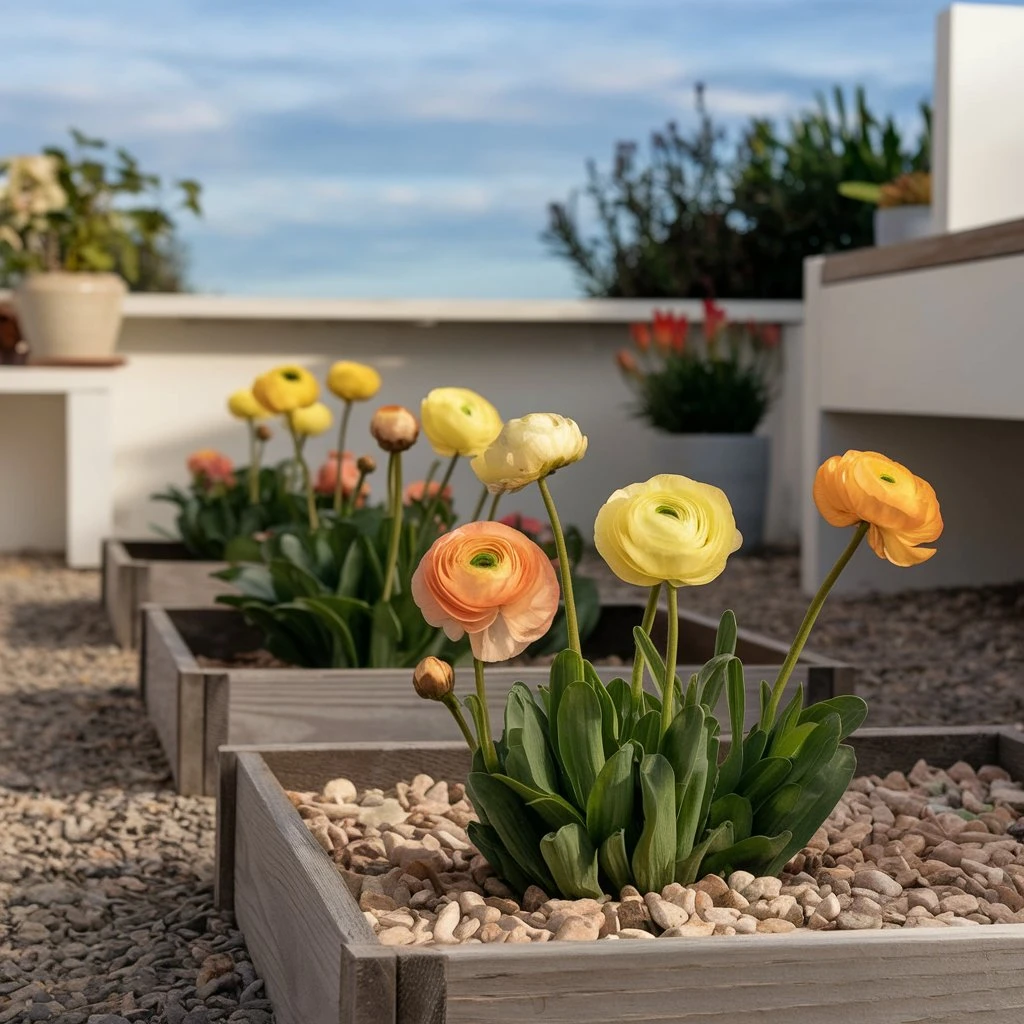
Troubleshooting Common Issues with Butterfly Ranunculus
Identifying and Solving Problems like Wilting, Yellowing, or Poor Growth
The butterfly ranunculus, famous for its breathtaking flowers, can occasionally encounter growing issues. Withering or yellowing leaves might indicate a problem. To identify these issues, start with a look at the plant’s surroundings.
- Plants wilt due to too much or too little water. Soggy soil and limp plant stems show excess watering. Conversely, wilting in dry soil indicates not enough watering. The soil should drain well. Regularly water your Butterfly ranunculus, but careful not to soak the roots.
- Leaves turning yellow can mean the plant doesn’t have enough nutrients, especially not enough nitrogen or iron. If the green veins are still visible on yellow leaves, it’s possibly an iron shortage. This is usually due to bad soil pH. Adding balanced fertilizer or changing the soil pH could help the plant get the nutrients it needs.
- Your butterfly ranunculus might not be growing well for different reasons. It could lack sunlight, have tight soil, or not enough room for roots. It’s crucial to plant it where it gets sunlight for at least six hours daily, either full or partial. Similarly, the soil should be loose and can drain water well. This way, the roots can develop healthily.
Best Practices for Disease Prevention and Treatment
Stopping butterfly ranunculus illnesses involves keen observation and suitable attention. Common fungal conditions include root decay and white fungus. Here are tips to reduce the danger:
- Stop too much watering: A top method to keep fungal infections away is to hydrate the plant at the bottom while letting the dirt have a dry spell between waterings. This cuts down on the wetness that fungus loves.
- Don’t squish the plants: Plants too close together have a higher risk of getting fungus because air can’t move around them well. When you’re putting butterfly ranunculus in the ground, make sure you leave enough room for air to pass between them. This can help avert disease.
- Regularly check leaves and stems: Spot any fungus symptoms, like discolored spots or mold growing on leaves. If you see these problems, quickly eliminate the damaged parts to stop the disease from spreading. Think about using a plant-safe fungicide.
- Choose strong species: Certain types of butterfly ranunculus are better at fighting common fungal infections. Explore the choices and pick ones that naturally combat diseases in your area.
Tips for Managing Adverse Weather and Environmental Stressors
Butterfly ranunculus can be impacted by harsh conditions like severe heat or cold, strong winds, or heavy rain. This is a guide to helping your plants flourish even under these tough circumstances:
- Guard against harsh breezes: Powerful winds can harm the tender blossoms of butterfly ranunculus. Setting up a barrier like a trellis or hedge can offer the crucial shield to keep your greenery secure from severe blasts.
- Guard against harsh breezes: Powerful winds can harm the tender blossoms of butterfly ranunculus. Setting up a barrier like a trellis or hedge can offer the crucial shield to keep your greenery secure from severe blasts.
- Shield from rain: Lots of rain may harm the petite petals of butterfly ranunculus and cause fungus problems. If storms are common where you live, think about using a cover or shade for your plants when it’s rainy.
- Shield from rain: Lots of rain may harm the petite petals of butterfly ranunculus and cause fungus problems. If storms are common where you live, think about using a cover or shade for your plants when it’s rainy.
Stay on top of things; fix problems at once. This way, your butterfly ranunculus will be healthy and their beautiful blooms will last all season.
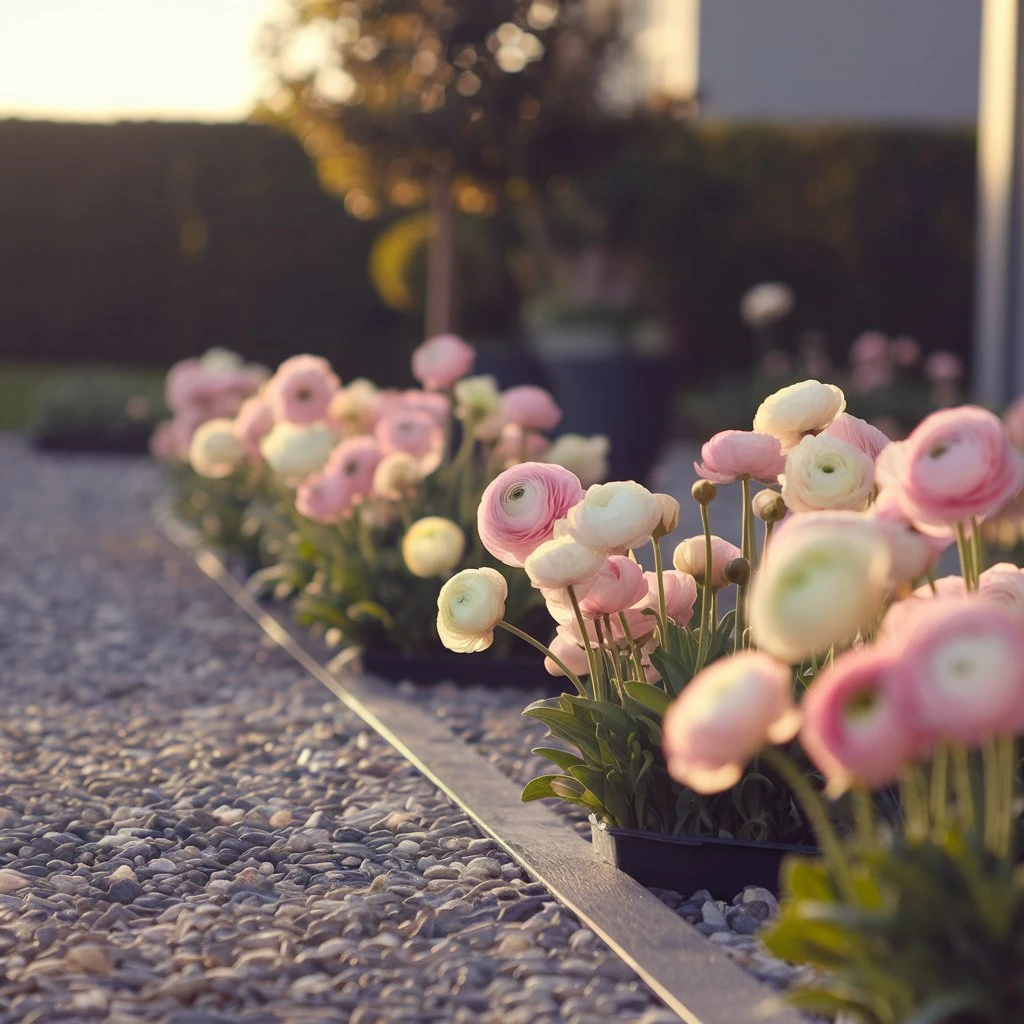
Summary of the Beauty and Benefits of Butterfly Ranunculus
Butterfly ranunculus is like the star of the garden. This flower has multiple layers of showy petals – think of butterflies darting around. They come in vibrant colors and add refined grace to gardens and flower bouquets alike. The real charm of butterfly ranunculus lies in its ability to fit in anywhere; it’s a beautiful lone centerpiece or a stunning part of a larger arrangement.
There’s more to the butterfly ranunculus than its enchanting looks. This tough little guy is easy-going. It grows well in soil that drains water quickly and doesn’t fuss much. It’s an early bird in spring, blooming first after winter’s gone.
This flower is friendly to bees and butterflies, drawing them to the garden and helping it grow stronger. Enjoy the butterfly ranunculus for its unique beauty or use it in your arrangements. Marvel at how it improves your garden’s health. No matter what, this flower is really a standout among perennials.
Encouragement to Grow Butterfly Ranunculus in Home Gardens and Floral Arrangements
If you wish to boost your garden’s appeal, the butterfly ranunculus is perfect. Its distinctive blooms enhance gardens easily, in flower beds, pots, or hanging baskets. Even newbie gardeners can grow this plant with ease, providing it with sunlight, water, and good soil. What’s more, the butterfly ranunculus does well in spring and fall, so your garden stays vibrant longer.
Its eye-catching colors lend an extra charm to flower arrangements, enriching them with pattern and motion. They make bouquets memorable, for special times or daily décor.
Having butterfly ranunculus in your garden does more than just make it look good – it gives you pride. As you help these exquisite plants flourish, you’ll feel a sense of achievement. So, think about including this mesmerizing flower in your garden or flower collection for its irresistible beauty and benefits to both nature and design.
Check out our latest article for more insights, and follow us on Facebook for updates! and connect with us on Instagram, Pinterest, and YouTube for more inspiration!
By: Mark


